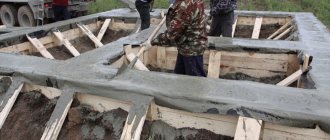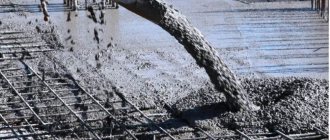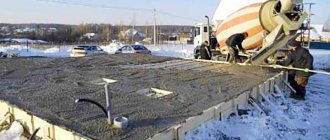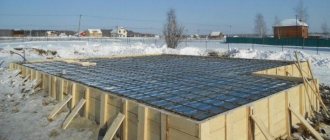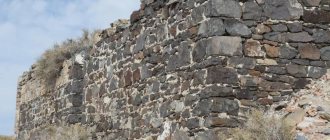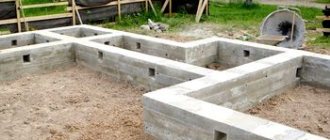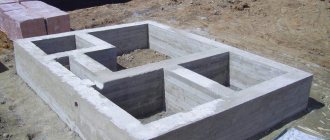Hardening the concrete of the house foundation. Hardening of concrete takes about a month.
Hardening of concrete occurs after it sets and lasts for a month. After 30 days, the solution finally hardens and is able to withstand various loads. The need for such a long period is due to the use of a thick layer for pouring foundations. The next layer of concrete is poured during the hardening process only on the third day; until this time the poured concrete cannot be touched. Because it is capable of cracking.
Cracks on the surface are not always visible, but they exist, which means they can manifest themselves at the end of the construction of buildings and structures. Thus, laying the working mixture in two layers should take no longer than 8 hours in the cold season, no more than four hours in the autumn and spring, and no more than three hours in the hot season. Laying of subsequent layers should be carried out on a flat, cleaned and dried surface.
Tips on grouting methods that take into account seams.
Laying concrete in parts requires not only compliance with time intervals, but also pouring methods, of which there are two: block and laying the mortar in layers. With a strip foundation with a filled trench underground, laying the working solution into the formwork should be carried out exclusively on the ground. This method will allow you to pour the mixture evenly end-to-end. With a monolithic strip foundation, block mortar should be laid. In this case, the seams will take a perpendicular position relative to the block joints.
Construction based on piles and grillages
This is one of the types of pile-and-tape buildings. The tape here will be slightly higher than the soil surface. Construction includes drilling wells for piles.
To make such a foundation, it is advisable to use special heavy concrete with quartz sand. The supporting part of the foundation can be made in several layers. Then, after three days, you can proceed to the installation of the grillage.
This step includes several main steps:
- installation of formwork on piles;
- installation of fittings;
- filling.
The height of this part should be approximately 300 mm. The width is slightly greater than the thickness of the walls. The upper part of the foundation can be made in parts, in several layers.
Methods for pouring the foundation in parts.
Is it possible to fill the strip foundation of a private house in parts?
Pouring the foundation in parts.
Concrete mortar can be laid in several ways, which depend on the time of the planned pouring. If the concreting process stops for less than 12 hours, then laying the mortar will consist of several parts. Upon completion of laying the part, the finished surface should be covered with roofing felt or film, which will prevent the solution from drying out. Before proceeding with subsequent installation on an already poured surface, you need to remove the concrete mortar from it.
Laying the mortar on the part of the mixture that has not yet hardened is called a “hot joint”. If the interval between laying the mortar exceeds 12 hours, then it is necessary to wait until the previous poured surface has completely hardened. If you neglect this advice, a crust will form on the laid concrete, under which the mixture will not have time to harden. When a new solution is laid on the crust, it will begin to crack under pressure, which will lead to undesirable consequences in the further operation of the foundation.
Layers when pouring the solution can be vertical and horizontal. The latter are laid at ½ half the height of the formwork and do not require delimitation. It is important to take into account the seam when laying the mortar; it should not be in the place where the reinforcing thread is located; it should be laid below or above the steel wire. Vertical pouring requires dividing the formwork using partitions.
Plasticizers
The addition of additives and plasticizers improves the fluidity of concrete, so that vibration of the concrete can be eliminated from the pouring process. This will reduce the impact of a new portion of solution on already filled layers.
The solution is mixed after preliminary calculation. When adding plasticizers, you must strictly follow the manufacturer's recommendations regarding dosage, since failure to comply with the proportions can lead to the opposite result.
Concrete mixing process
Technology of the pouring process in parts.
To build a strong monolithic structure, concrete should be supplied to the workplace continuously.
Is it possible to pour the foundation in parts using a concrete mixer?
The mixer machine will ensure uninterrupted pouring of concrete.
This supply will be provided by a mixer machine, which will speed up the concreting process and simplify it. The concrete mixer contains eight cubes of the working mixture; it is delivered to the construction site for further work. However, it is not always possible to carry out concreting in one step. The reasons for this are different: the machine with the concrete mixture is not delivered on time, there is not enough daylight hours, or the mixture is prepared with one’s own hands in a special concrete mixer, which requires time, which means it will not be possible to carry out concreting in one day. Therefore, it is necessary to lay the working mixture in parts.
Before starting concreting, it is important to prepare the formwork; it is installed around the area to be poured. When the formwork is fixed, concrete composition begins to be poured into it. You can prepare a concrete mixture yourself or purchase it at hardware stores. But in the first and second cases it should be diluted with water. Therefore, it is important to monitor the amount of liquid poured, because the brand of concrete will directly depend on it. The solution should resemble sour cream and not be too watery, otherwise it will take a lot of time to harden even at above-zero temperatures.
After the concrete mixture is prepared, you should start pouring it. Pour it into the formwork evenly in one stream. If you pour liquid on different sides, then the foundation will not be level. When the mortar is laid, it should be leveled and compacted. The compaction of the poured surface is carried out with a special tool, with the help of which vibration waves are created. If you don’t have such a tool, you can use a regular wooden plank, but you shouldn’t expect an ideal effect from it. The mixture must be compacted until the air bubbles leave the mixture.
Before proceeding with subsequent concreting, you need to maintain a time period, this applies to the horizontal method. When the area is filled, it must be covered with a special material that will protect the laid surface from precipitation and direct sunlight.
Is it possible to fill the foundation slab in parts?
To improve strength, plasticizers are added to concrete.
To improve the strength characteristics of concrete mortar, plasticizers can be added to it. Their use eliminates vibration of the poured surface and reduces the pressure from the new part of concrete on the previously laid one. In order for the results from additives to be positive, it is important to observe proportionality when adding them to the mixture.
To ensure that the poured surface is strong, reliable and free of cracks, it is important to adhere to the following recommendations:
- It is important to plan out the steps of the process.
- The area where work is planned should be divided into sectors.
- Taking into account the laying plan of the mixture, distribute its volume, which should be supplied to the construction site.
- The working mixture must be laid evenly over the entire surface.
- To maintain the strength of the base and avoid seams, time intervals must be observed.
- When pouring the foundation of buildings in parts, it is important to take into account the recommendations for reinforcement.
The main mistakes when pouring the foundation in parts.
To build a solid foundation, it is important to follow the recommendations and avoid the following mistakes:
- Some builders do not consider it necessary to think through the pouring plan and begin the work process right away. A prepared work plan will save valuable time and eliminate downtime, which means it will be possible to complete concreting on time.
- Another mistake is uneven laying of the working mixture over the entire area of the site.
- Using the “cold joint” method, builders do not clean the previously poured surface from cement laitance. The cement film can be removed using a hammer or a chemical compound.
- When using the “hot joint” concreting method, the poured surface is not covered with roofing felt or film.
- In winter, the concrete surface is not cleared of ice or snow.
In order to pour a strong, reliable foundation in parts, which will serve as the basis for buildings and structures for many decades, it is important to follow the recommendations for laying concrete in this way. The main condition for a strong foundation is a high-quality solution, which must be prepared based on the strict ratio of the necessary components.
Laying the mixture in parts is not difficult, but its implementation must take into account time intervals.
Formation of concrete surface
Pouring concrete at an angle is a simple operation that you can do yourself. The quality of concrete work is determined by the consistency of the prepared mortar, correctly executed reinforcement, and the accuracy of leveling the concrete surface.
When carrying out the concreting process, perform the following operations:
Pouring concrete in two layers will improve the presentation of the surface. To do this, you can initially fill half of the formwork with ordinary mortar, and fill the second part with concrete with a reduced concentration of crushed stone. This will make leveling with the rule easier.
Remember that the main problem causing deterioration in presentation and strength is drying out of the composition. Therefore, throughout the week, moisten the concrete mass, which can be covered with plastic film to preserve moisture.
Why layer-by-layer filling?
Is it possible to fill the foundation in parts with reinforcement?
Private developers do not always have the opportunity to use such equipment, because it is quite expensive, and for small areas such an approach may be unacceptable due to the lack of access roads for equipment. This problem can be partially solved using a concrete mixer, but the volume of mixture that can be prepared in one load is limited. In this case, builders are wondering whether it is possible to fill the foundation in parts, because this sometimes affects the strength of the foundation and its operational properties.
Repair work
Sometimes there comes a time when the basic level requires renovation. It is much easier and cheaper to make a new base part. Replacing the foundation in parts will cost significantly more than a complete replacement. But you can try pouring the mixture into several layers.
In general, the entire repair consists of digging a trench around the perimeter and cleaning out cracks. Then you should use anchors to strengthen the reinforcement and proceed to pouring a new solution. This will strengthen the current base and stop cracking.
Maturing of concrete.
Concrete is a mixture of fillers and cement that are mixed with water. To increase fluidity, give the mixture special properties and increase frost resistance, plasticizers and additives can be added to concrete during mixing. At this stage, you may also be wondering whether it is possible to fill the foundation in parts. Pouring a liquid solution into a form called formwork involves the beginning of irreversible processes in concrete, namely:
During the first stage, the solution begins to come into a solid state, because water and cement components interact with each other. But the bonds between the ingredients remain not strong enough, and if a load is applied to the material, it may collapse, and the solution will not re-set.
Polypropylene fiber
Universal polypropylene reinforcing fiber for adding to the solution.
More details
But the concrete mixture can be made more mobile and do without labor-intensive vibration processing if you use the CemBase additive, adapted to cements and domestically produced aggregates, which also provides additional advantages:
- reducing the amount of water in the mixture;
- cement savings from 10%;
- facilitating mixing of concrete mixture;
- increasing the strength and durability of concrete;
- increasing water resistance and frost resistance of concrete;
- reducing the likelihood of cracks;
- reduction of shrinkage.
Also, to prevent cracks, polypropylene or basalt fiber is added to the concrete for the foundation.
We advise you to study: For foundations, tiles and paths
What else you need to know about the stages.
Is it possible to fill a strip foundation in parts?
This phase can vary depending on the air temperature and lasts from 3 hours to a day. As the temperature decreases, concrete takes longer to set. At the initial stage, it remains liquid, without changes. If during this period a new portion of concrete is added to the formwork, then destruction of the cement bonds will not occur.
At a temperature of 20 °C, the liquid stage will last for 2 hours, but if the temperature drops to zero, then this period will last for 8 hours. The time before setting begins can be extended by constantly mixing the concrete, but its characteristics will be improved, so you should not abuse the method.
Preparation of concrete solution
Depending on where the pouring is planned and the magnitude of the load perceived by the site, the required brand of concrete solution is selected. The intensity of use also determines the grade of concrete used, which should be:
- M600 – for access areas to garages and areas where vehicle traffic occurs.
- M500 – for making blind areas, paths, and recreation areas.
- M400 – for forming a screed located indoors.
The efficiency of concreting is determined by the quality of the batch, which depends on the accurate calculation of the quantities of sand and crushed stone
For pouring, use purchased mixtures or prepare your own concrete solution using the following ingredients:
- Portland cement grade M400 and higher;
- small crushed stone;
- sifted river sand;
- water.
The amount of crushed stone and sand used should be 5 times higher than the proportion of cement if concrete grade M500 is being prepared. As the grade of binder used increases, the strength characteristics of the concrete mass being formed increase.
Follow these guidelines:
Pouring concrete at the hardening stage.
Is it possible to fill the foundation in parts?
If you are faced with the question of whether it is possible to fill the foundation in parts, you should also study the stage of concrete hardening. This phase will last quite a long time, because the components will gain strength over many years. The first 28 days are considered a mandatory period for the structure to remain in place until it gains strength. In this case, hardening occurs quickly, which is especially important for the first day; after that the speed slows down.
In the first hours after setting, the concrete will not have such a high hardness, and if you add another portion, this may cause small cracks to appear, because the load on the structure will increase. After three days, these loads do not have a similar effect on the first layers. Taking into account the peculiarities of the maturation of the solution, it can be argued that pouring the foundation in parts can be carried out, however, it is important to follow certain rules.
Recommendations for pouring the foundation in parts.
Is it possible to fill the foundation of a private house in parts?
When a private developer wonders whether it is possible to fill the foundation in parts, first he must study certain rules for carrying out such work. They state that when mixing individual batches of concrete in succession, you should limit yourself to two hours or less between pours in warm weather. If work is carried out in the off-season, then this time can be increased to 4 hours. The strength of the foundation does not change, and seams are not formed.
If you are wondering whether it is possible to fill the foundation in parts, then you must remember that long breaks in work should not exceed three days. After the break, the base of the foundation, where a fresh portion is supposed to be poured, should be cleaned of moisture, dust and dirt. It is important to clean with a wire brush. In this case, the seam will have good adhesion.
Step-by-step instructions for pouring the foundation in parts.
Is it possible to fill the foundation of a house in parts?
It is better to pour the foundation continuously; sometimes work is not stopped for this even at night. As a result, it is possible to obtain a monolithic structure that has a high load-bearing capacity. But continuous pouring can be achieved only if you use a purchased solution, which will be supplied to the formwork from the concrete mixer tank. If the solution is prepared directly at the construction site, then instead of this technology, the partial pouring technique is used.
When asking the question of whether it is possible to fill a strip foundation in parts, you should know that if certain conditions are met, such a structure will not be inferior in terms of strength to the one formed using the monolithic pouring method. The technology of intermittent casting is as follows: at the first stage, it is necessary to form a reinforcement frame, which will consist of horizontal rods. They need to be separated by vertical connections. The distance between the horizontal rods should be selected according to the volume of fill. Usually it ranges from 10 to 12 cm.
Is it possible to fill the foundation in parts using formwork?
If you are thinking about the question of whether it is possible to fill the foundation in parts, you should read useful tips. From them you can find out that at the next stage you can prepare a solution to pour the first layer of concrete. In this case, the formwork should be filled evenly, while the thickness of the first layer should be equal to the distance between the horizontal rods, which should be reduced by 1.5 cm. This answers the question of how the foundation can be filled in parts with reinforcement. The second layer will flow under the horizontal reinforcement. As soon as the filling of the first layer has been completed, you can begin to prepare the second portion of the solution, which is poured from above.
This technique should be followed until the desired base height is achieved. The technology is also called layer-by-layer, and the individual layers will be fastened together with reinforcement. However, if the first layer has already begun to set and has reached the hardening stage, then the second pour can begin only after the first layer has hardened.
Many novice home craftsmen wonder whether it is possible to fill the foundation in parts; the instructions presented in the article will help you understand this. From it you can learn that after pouring the first layer, when it is not intended to immediately begin forming the second, the surface should be wrapped in polyethylene, which will prevent unwanted evaporation of water. In this case, the second layer can be formed the next day; first, concrete milk must be removed from the surface.
Where is inclined concreting required?
Activities for the formation of an inclined surface are divided into the following types:
- internal work carried out inside residential and commercial premises;
- street events carried out in natural conditions.
By pouring concrete on a slope, the following surfaces can be formed:
Often there is a need to lay concrete on a slope
The main goal when carrying out construction activities is to form a monolithic foundation with high strength and durability.
Recommendations for choosing a concrete grade.
Is it possible to fill the foundation of a private house in parts with reinforcement?
If you have not had experience pouring a foundation before, then you first need to think about what brand of concrete you will use. It is recommended to pay attention to the operating conditions of the future design. This is due to the fact that different brands are characterized by a certain moisture resistance and frost resistance. If you are faced with the question of whether it is possible to fill the foundation in parts, and what kind of concrete to carry out this work, you must definitely decide.
For difficult conditions, varieties M-300 and M-450 are usually used. If the conditions are not so severe, then concrete grades M-100 and M-200 can be used. M-100 and M-450 are prepared from the same ingredients, but the recipes are different. For example, M-100 is mixed from:
- 4 parts sand;
- 1 part cement;
- 6 parts gravel.
Whereas to prepare M-450 you should use:
- one part sand;
- one part cement;
- two parts gravel.
In order for cement stone to form, the solution will require 1 part water to 4 parts cement. But when you study the ratio of cement and water, you will understand that most often the proportions look like this: 3 to 2 and 2 to 1.
Is it possible to pour the foundation for a house in high quality parts?
- Taking into account time intervals when pouring in parts Intervals during setting
- Accounting for curing time
When building a house, in any case, the question arises: is it possible to fill the foundation of a house in parts and will such pouring affect the quality of the foundation? This question arises among people on the basis that the main pouring of the foundation all at once requires not only great effort, but also the presence of special equipment and machines. We are not talking about cranes or excavators. The thing is that there is simply nowhere to mix a large amount of concrete for pouring. Yes, and everything needs to be poured very quickly, since concrete tends to harden gradually.
Is it possible to fill the strip foundation of a house in parts?
Pouring concrete in parts does not reduce the quality of the foundation.
Today there is a technology for pouring the foundation in parts, which does not reduce its quality.
Therefore, the answer here is clear: you can fill the foundation in parts. This is especially suitable for strip foundations, where the largest amount of pouring solution is spent.
Taking into account time intervals when pouring in parts.
Scheme of pouring the foundation of a house.
Before we consider in detail one of the methods of pouring parts of the foundation, it is advisable to understand several important points. They relate to the time and intervals of hardening of concrete mixtures. This is extremely important, since incorrect timing can reduce the quality of the foundation.
An important issue is the hardening stages of the concrete mixture. There are two such stages in total. This is setting and hardening. Both processes have their own characteristics and their own time intervals.
These characteristics differ for different mortars and brands of concrete. However, concrete for pouring into a strip foundation all has the same parameters and features.
Intervals during setting.
Scheme of the macrostructure of concrete.
Setting is the very first process in the solution, which occurs immediately after pouring the formwork. It is characterized by the gradual binding of individual components of the solution to each other. The setting time is theoretically a little dangerous, since if the concrete is touched during this time, its structure in this place can deteriorate, as a result of which the setting will be weak or not set properly at all.
The minimum setting time is 3 hours. This is typical if the ambient air temperature is above 15°C. The maximum time is one day. This is more true when it’s frosty outside. Therefore, the higher the temperature, the faster the solution will set. This process is characterized only by the beginning of solidification. At the same time, the structure remains liquid. When pouring in parts over a period of up to 8 hours, you can pour a new, not too thick layer of concrete on top, and this will not cause any defects. If you do this right away, when one day has passed, the base may deteriorate considerably.
Accounting for time during hardening.
Concrete calculation table for the foundation of a house.
Concrete mix composition table.
The second stage is called hardening. It lasts for a whole month. Only at the end of this period will the concrete be fully hardened and ready for any load. Such a long period is explained by the fact that a fairly thick layer of mortar is poured into the foundation, which takes a long time to completely harden.
When the hardening period begins, the next part of concrete can be poured only after three days. This cannot be done for a day to three days, as numerous significant cracks may appear in the concrete. Moreover, you may not even see them, since they will be located in the thickness of the layers. But they will make themselves known very soon after the construction of the house is completed.
Based on the above, there are two main things to remember. Firstly, pouring the second layer can be done no more than 8 hours later in winter, no more than 4 hours in spring or autumn, and no more than 3 hours in summer. If you are going to pour the next layer after the previous solution has completely hardened, then the base will need to be prepared: dry and clean with a metal brush. And only then can you start filling again.
Tips on grouting methods that take into account seams.
Calculation of concrete mixture.
In addition to the time intervals, proponents of pouring a foundation have another important question. It concerns specific pouring methods. There are two of these methods: block and layer-by-layer pouring of concrete. In this regard, it is recommended to adhere to the following rules:
- If the foundation is strip and the trench is poured underground, the formwork should be poured strictly along the ground. In this case, the formwork is poured exactly end-to-end, that is, it will be a layer-by-layer pour.
- If your foundation is strip monolithic, then it is recommended to do block filling. That is, the seams should be located perpendicular to the joints of the monolith blocks. An option with layer-by-layer filling is also possible here, but in this case it is necessary to provide for the presence of strong vertical reinforcement.
Considering all these tips, you can start pouring the foundation in parts. This process is carried out in most cases in the same way as regular pouring. But you just need to fulfill the main requirements regarding the filling method and time intervals.
Review of methods and drawing up a sketch.
Construction of the foundation of the house.
Before you start pouring, draw up a small three-dimensional diagram of the foundation for yourself. The diagram involves designating places that will be divided into parts for pouring concrete. There are three main ways of division.
The first method is a vertical section. In this case, the base of the foundation must be divided into the required number of separate parts, which are separated from each other by partitions made of strong metal. After hardening, the partitions are removed and pouring continues. If such filling is expected, mark these parts immediately on the sketch.
The second method is oblique filling. This is the most complex method of filling, which is completely impractical and unprofitable to use for small residential buildings. It is used for complex structures and is produced in most cases by experienced professionals. The bottom line is that the territory is divided into parts by diagonals, between which there must be angles of a certain size (usually 45 degrees).
The third method is the horizontal type of pouring the foundation in parts. In this case, the depth of the entire foundation is conditionally divided into several parts (layers). There is no need to place partitions between the parts if you do not use the vertical pouring method. You can simply determine the height of the layers for yourself and put everything on the sketch. And then fill in according to the sketch.
It is advisable to even indicate on the sketch the specific dimensions and depth of the parts to be filled with mortar. And after each individual fill, cross out the treated areas on the sketch, and also mark the end time of the fill. This will make it much easier for you to navigate the process.
How to pour the frame correctly?
After arranging the formwork and reinforcing frame, you can proceed directly to pouring the concrete mixture. The material should be poured in the direction from the corner areas to the central points of the formwork.
The supply of concrete should be carried out using special equipment - an automobile concrete mixer . Manual preparation of the material will require a lot of time and labor.
In the process of pouring the cement-sand mixture, it is also recommended to use internal vibrators. The use of such equipment will remove air bubbles from the composition, thereby increasing its strength and reducing the risk of premature destruction.
In the absence of a deep vibrator, you can use the bayonet method using a special bayonet shovel.
What do you need to work independently?
The main difficulty when doing the work yourself is that it is necessary to pour the concrete mixture in a relatively short time so that it hardens more evenly.
Therefore, it is not advisable to mix the material in ordinary buckets or metal troughs ; in this case, the creation of the foundation will take several days.
It is advisable to use a concrete mixer of a suitable size; if possible, you should rent the appropriate special equipment (concrete pump).
How to level the foundation?
In the process of leveling a concrete strip, it is necessary to determine the highest and lowest points of its surface using a water or laser level . Then horizontal formwork (plank or metal) is placed along its perimeter.
It must be securely secured in a stationary position so that the frame does not move during subsequent work.
On the inner sides of the formwork you need to make markings and apply horizontal lines measured using a laser or liquid level. Next, along the marked lines, the formwork is filled with fresh concrete.
At the final stage, the cement-sand mass must be carefully leveled using a building rule, which you can make yourself from a fragment of an edged board.
How long does it take for complete hardening?
The period of time during which the cement-sand mixture acquires the necessary strength margin and finally hardens is determined by several factors.
The duration of the process depends on the brand of material and the percentage of water in it , which can differ significantly for concrete mixtures of different strength classes.
The hardening time is also affected by ambient temperature and air humidity. At +30 °C, strength development occurs almost 2 times faster than at +5 °C.
On average, the concrete mixture hardens in 20-30 days . The process can be accelerated by using various concrete heating technologies.
A certain voltage is applied to the metal reinforcement; when current passes, the metal generates heat and accelerates the hardening of the concrete mixture.
